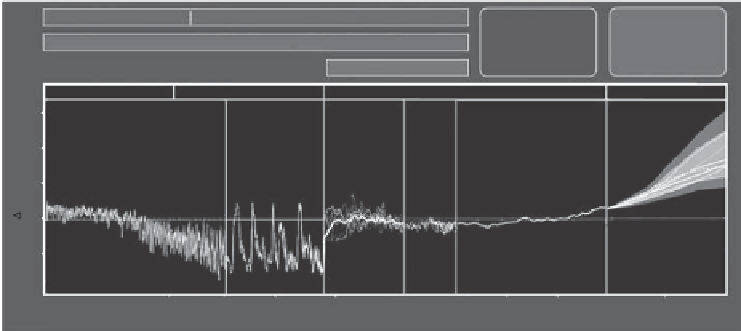Geoscience Reference
In-Depth Information
Palaeoecological record
Phylogeography
20th Century
record
Future
forecasts
Phylochronology
Pliocene
Pleistocene
Holocene
Future
6
4
2
0
-2
5
43 2
1
500
250
10
52
1
-150 100
-50
+50
+100
Million Yrs BP
Thousand Yrs BP
Years before (-) or after (+) present
Figure 5.1
Global mean temperature fluctuations, past, present, and future. Note the difference in scale
on the x axis, and that forecasts under higher-emissions scenarios exceed the long-term natural range of
variability. BP means before present (Moritz and Agudo, 2013)
through field observations and experiments. This knowledge can inform the development of
computer simulations that relate distribution to climate parameters, either through direct
correlation or through a mechanistic understanding of how and why the reproduction, sur-
vival, and mortality of species and populations are affected by climate (Figure 5.2). Such sim-
ulations can help biodiversity conservation in numerous ways, including the development
protected area networks that can facilitate climate-induced migration and accommodate
range shifts (Dawson et al. 2011, Gillson and Marchant 2014). Palaeoecology can also aid in
understanding the feedbacks between vegetation, regional climate, and land-use, thus guid-
ing the management of land inside and outside protected areas, and in ameliorating and
adapting to the effects of climate change.
Humans are currently changing the Earth's radiation balance, by increasing the concentra-
tion of greenhouse gases in the atmosphere, and thus trapping more heat (IPCC 2007).
However, these modern, anthropogenically driven changes in climate are taking place
against a backdrop of other climatic variations, driven by a multitude of factors, including
changes in the Earth's orbit, volcanic eruptions, and changes in the number of sunspots. For
the past 2.5 million years, the Earth has undergone periods of expanding and contracting ice
sheets, known as glacial-interglacial cycles. These are caused by changes in the Earth's orbit,
which varies cyclically on a range of timescales. Today's interglacial period, the Holocene,
began around 11,000 years ago, and it is about 22,000 years since the last glacial maximum.
Though the Holocene climate is often considered stable, orbital effects led to significantly
warmer global temperatures, during the mid-Holocene Altithermal (MHA), about 9,000-
5,000 years ago. Even during the past 2,000 years, there have been at least two warmer


Search WWH ::

Custom Search